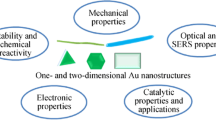Abstract
This study explained a procedure to synthesize 3D hexagram gold nanoparticles using a specific morphologically controlled gold precursor reduction. Acetaldehyde acted as the reducing agent along with polyvinyl pyrrolidone as the stabilizing agent with a limited reaction temperature range observed to be near to 25 °C. The resulting special gold nanoparticles were physically characterized and observed to possess an average planar size of 420 nm, an average central thickness of 200 nm, and an average edge thickness of 18 nm. Furthermore, a mechanism model was proposed to describe the oriented growth of gold nanoparticles employing published accounts of the mechanisms involved in the growth of gold hexagonal nanoplates. Moreover, the two major factors that controlled the morphology of synthesized gold nanoparticles were elaborated to provide reference for future fabrication methods of metal nanoparticles in both academia and industry.








Similar content being viewed by others
References
Narayanan R, El-Sayed MA (2005) Catalysis with transition metal nanoparticles in colloidal solution: nanoparticle shape dependence and stability. J Phys Chem B 109(26):12663–12676
Hvolbæk B, Janssens TVW, Clausen BS et al (2007) Catalytic activity of Au nanoparticles. Nano Today 2(4):14–18
Chen MS, Goodman DW (2008) Catalytically active gold on ordered titania supports. Chem Soc Rev 37(9):1860–1870
Zhu WL, Zhang YJ, Zhang HY et al (2014) Active and selective conversion of CO2 to CO on ultrathin Au nanowires. J Am Chem Soc 136(46):16132–16135
Xu ML, Yang XK, Zhang YJ et al (2015) Enhanced methanol oxidation activity of Au@Pd nanoparticles supported on MWCNTs functionalized by MB under ultraviolet irradiation. Rare Met 34(1):12–16
Huang YF, Sefah K, Bamrungsap S et al (2008) Selective photothermal therapy for mixed cancer cells using aptamer-conjugated nanorods. Langmuir 24(20):11860–11865
Parab HJ, Chen HM, Lai TC et al (2009) Biosensing, cytotoxicity, and cellular uptake studies of surface-modified gold nanorods. J Phys Chem C 113(18):7574–7578
Grabinski C, Schaeublin N, Wijaya A et al (2011) Effect of gold nanorod surface chemistry on cellular response. ACS Nano 5(4):2870–2879
Wijaya A, Hamad-Schifferli K (2008) Ligand customization and DNA functionalization of gold nanorods via round-trip phase transfer ligand exchange. Langmuir 24(18):9966–9969
Harry SR, Hicks DJ, Amiri KI et al (2010) Hairpin DNA coated gold nanoparticles as intracellular mRNA probes for the detection of tyrosinase gene expression in melanoma cells. Chem Commun 46(30):5557–5559
Gao D, Sheng Z, Han H (2011) An ultrasensitive method for the detection of gene fragment from transgenics using label-free gold nanoparticle probe and dynamic light scattering. Anal Chim Acta 696(1–2):1–5
Ming T, Zhao L, Xiao M et al (2010) Resonance-coupling-based plasmonic switches. Small 6(22):2514–2519
Shao L, Woo KC, Chen H et al (2010) Angle- and energy-resolved plasmon coupling in gold nanorod dimers. ACS Nano 4(6):3053–3062
Zijlstra P, Chon JWM, Gu M (2009) Five-dimensional optical recording mediated by surface plasmons in gold nanorods. Nature 459(7245):410–413
Sau TK, Rogach AL, Jäckel F et al (2010) Properties and applications of colloidal nonspherical noble metal nanoparticles. Adv Mater 22(16):1805–1825
Liao HG, Jiang YX, Zhou ZY et al (2008) Shape-controlled synthesis of gold nanoparticles in deep eutectic solvents for studies of structure-functionality relationships in electrocatalysis. Angewandte Chemie 47(47):9100–9103
Mahmoud MA, El-Sayed MA (2010) Gold nanoframes: very high surface plasmon fields and excellent near-infrared sensors. J Am Chem Soc 132(36):12704–12710
Dertli E, Coskun S, Esenturk EN (2013) Gold nanowires with high aspect ratio and morphological purity: synthesis, characterization, and evaluation of parameters. J Mater Res 28(2):250–260
Loubat A, Lacroix LM, Robert A et al (2015) Ultrathin gold nanowires: soft-templating versus liquid phase synthesis, a quantitative study. J Phys Chem C 119(8):4422–4430
Vigderman L, Zubarev ER (2012) Starfruit-shaped gold nanorods and nanowires: synthesis and SERS characterization. Langmuir 28(24):9034–9040
Chen L, Ji F, Xu Y et al (2014) High-yield seedless synthesis of triangular gold nanoplates through oxidative etching. Nano Lett 14(12):7201–7206
Huang Y, Ferhan AR, Gao Y et al (2014) High-yield synthesis of triangular gold nanoplates with improved shape uniformity, tunable edge length and thickness. Nanoscale 6(12):6496–6500
Roh J, Back SH, Ahn DJ (2016) Shape-persistent replica synthesis of gold/silver bimetallic nanoplates using tailored silica cages. Small 12(10):1322–1327
Daeha S, Choong IY, Im SC et al (2008) Shape adjustment between multiply twinned and single-crystalline polyhedral gold nanocrystals: decahedra, icosahedra, and truncated tetrahedra. J Phys Chem C 112(7):2469–2475
Li J, Chang M, Peng H et al (2014) Growth of elongated tetrahexahedral gold nanoparticles with high-index facets and their enhanced electrocatalytic properties. Mater Lett 120:216–218
Seo D, Park JC, Song H (2006) Polyhedral gold nanocrystals with Oh symmetry: from octahedra to cubes. J Am Chem Soc 128(46):14863–14870
Zhang J, Liu H, Wang Z et al (2007) Synthesis of gold regular octahedra with controlled size and plasmon resonance. Appl Phys Lett 90(16):3295–3303
Liu M, Guyot-Sionnest P (2005) Mechanism of silver(I)-assisted growth of gold nanorods and bipyramids. J Phys Chem B 109(47):22192–22200
Smith DK, Korgel BA (2008) The importance of the CTAB surfactant on the colloidal seed-mediated synthesis of gold nanorods. Langmuir 24(3):644–649
Murphy CJ, Sau TK, Gole AM et al (2005) Anisotropic metal nanoparticles: synthesis, assembly, and optical applications. J Phys Chem B 109(29):13857–13870
Zhu C, Peng HC, Zeng J et al (2012) Facile synthesis of gold wavy nanowires and investigation of their growth mechanism. J Am Chem Soc 134(50):20234–20237
Lofton C, Sigmund W (2005) Mechanisms controlling crystal habits of gold and silver colloids. Adv Func Mater 15(7):1197–1208
Author information
Authors and Affiliations
Corresponding author
Rights and permissions
About this article
Cite this article
Sun, J., Zhang, P., Fu, S. et al. Three-Dimensional Hexagram Gold Nanoparticles: Synthesis and Growth Mechanism. Trans. Tianjin Univ. 25, 31–37 (2019). https://doi.org/10.1007/s12209-018-0127-9
Received:
Revised:
Accepted:
Published:
Issue Date:
DOI: https://doi.org/10.1007/s12209-018-0127-9




